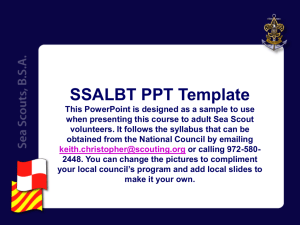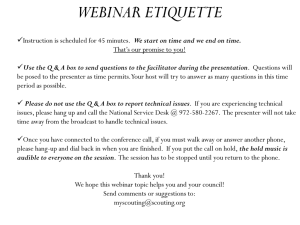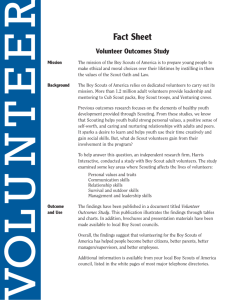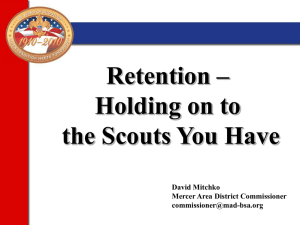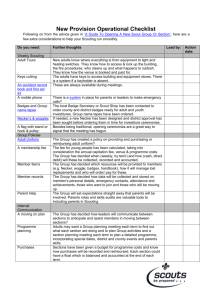Sea Scout Basic - Scatacook District
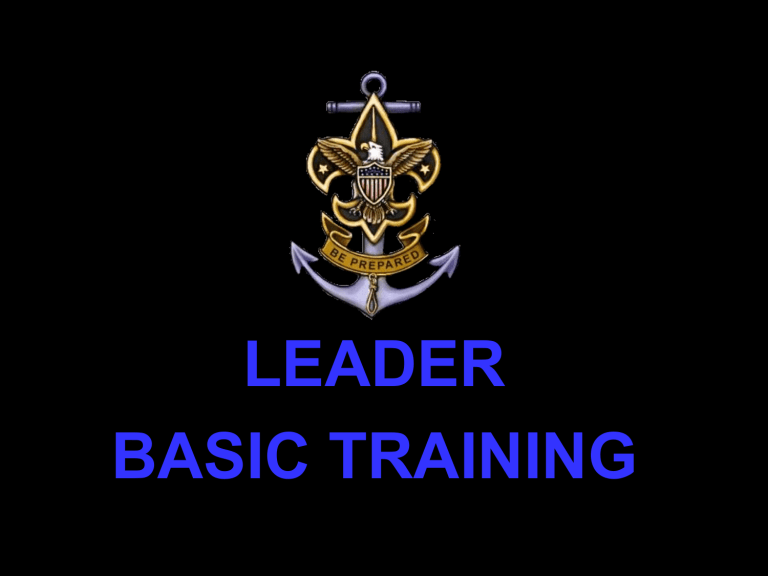
LEADER
BASIC TRAINING
HERE’S SEA SCOUTING
MISSION OF THE BSA
The mission of the Boy Scouts of America is to prepare young people to make ethical choices over their lifetimes by instilling in them the values of the Scout Oath and Law
THE VENTURING OATH
As a Venturer,
I promise to do my duty to God and help strengthen America, to help others, and, to seek truth, fairness, and adventure in our world .
VENTURING CODE
As a Venturer, I believe that America’s strength lies in our
Trust in God and in the courage, strength, and traditions of our people.
I will, therefore be faithful in my religious duties and will
Maintain a personal sense of honor in my own life.
I will treasure my American heritage and will do al I can to
Preserve and enrich it.
I will recognize the dignity and worth of all humanity and
Will use fair play and goodwill in my daily life.
I will acquire the Venturing attitude that seeks the truth in all things and adventure on the frontiers of our changing world.
SEA PROMISE
As a Sea Scout I promise to do my best:
• To guard against water accidents
• To know the location and proper use of the lifesaving devices on every boat I board
• To prepare to render aid to those in need
• To seek to preserve the motto of the sea:
Women and Children First.
WHAT IS SEA SCOUTING?
Sea Scouting is a youth development program of the
Boy Scouts of America for young men and women who are at least 14 years old (and have completed the eighth grade) through 20 years of age.
Local community organizations establish a Sea Scout
Ship by matching their people and program resources to the interests of young people in the community. The result is a program of exciting and meaningful activities that helps youth pursue their special interests, to grow, to develop leadership skills, and to become good citizens.
SEA SCOUT UNIFORM
It is recommended that your ship use a uniform in either the Coast Guard or Navy style. Whatever is chosen should be worn by all members and leaders. Sea Scout uniforms come in two classes – dress uniforms (blue and white) and work uniforms
(winter and summer).
More information on uniforms may be found in the Sea Scout Manual.
SEA SCOUT SHIP
The Sea Scout ship is a youth-led organization that recruits members, elects officers, and plans programs based on the chartered organizations program inventory.
Adult advisors provide training and guidance for the ship’s elected officers.
CHARTERED ORGANIZATIONS
Support their ship by:
• Conducting a program inventory of adults willing to provide program help with careers, skills, facilities and ideas.
• Providing adult leaders who organize the inventory and serve as advisors to the ship’s elected youth leaders.
• Providing meeting facilities
BOY SCOUTS OF AMERICA
The Boy Scouts of America recruits adult volunteers and assigns staff members to provide the following services for Sea Scout chartered organization’s ships
.
BOY SCOUTS OF AMERICA COMMITMENT
• Leadership training for adult leaders and elected officers
• Guidance on how to organize a ship and keep the program going successfully
• Methods for recruiting Sea Scouts, including an interest survey of local high school students.
• Regular communication with each ship to provide program support
BOY SCOUTS OF AMERICA COMMITMENT
• Use of council facilities, such as camps and equipment
• Planning Sea Scout activities that enrich the ship’s program
• Liability insurance coverage
METHODS OF SEA SCOUTING
• Voluntary association between youth and adults
• Ethical decision making
• Group activity
• Recognition of achievement
• Democratic Process
• Sea Scouting is about curiosity, exploration and adventure
SEA SCOUTING
EXPERIENCE AREAS
• Develop better Understanding of America’s social, economic, and governmental systems
• Encourage a pride in our
American heritage
SEA SCOUTING
EXPERIENCE AREAS
• Instilling stable personal values firmly based on religious concepts
• Developing skill in dealing with all people and encouraging a sense of family and community responsibility
SEA SCOUTING
EXPERIENCE AREAS
• Developing leadership skills
• Preparing to give leadership and fulfill our responsibilities to American society and to the people of the world
SEA SCOUTING
EXPERIENCE AREAS
• Developing a degree of selfreliance based on courage, initiative, and resourcefulness
• Understanding and appreciating the wise use of resources and the protection of our environment.
SEA SCOUTING
EXPERIENCE AREAS
• Encouraging the skill and the desire to help others
• Gaining a keen respect for the basic rights of others
SEA SCOUTING
EXPERIENCE AREAS
• Improving mental, emotional, and physical fitness and an appreciation for sports
• Developing ethical decision making skills
SKIPPER’S RESPONSIBILITIES
The Skipper’s responsibilities include:
•
Fostering a sense of community within the ship
•
Developing the youth to lead, plan, make decisions, and carry out a long term program of activities
•
Encourage participation and support for your ship
•
Uphold standards and policies of sponsoring organization and the Boy Scouts of America
SKIPPER’S RESPONSIBILITIES
•
Protect young people in your Sea Scout ship from abuse and neglect and upholding the standards of the Boy Scouts of America Youth Protection emphasis
•
Ensure the activities are conducted within safety guidelines and requirements
•
Cultivate the Sea Scouting spirit within your ship
UNDERSTANDING
AND
PROTECTING
YOUTH
ADOLESCENT DEVELOPMENT ISSUES
Important development issues facing Sea Scouts
• Experimentation
• Movement from dependence to interdependence
• Social Relationships
• Physiological changes and sexual maturity
• Reevaluation of values
ADOLESCENT DEVELOPMENT
Teenagers deal with opposing emotions:
• They fear and crave independence
• They face a constant struggle for power and independence
• They want to be unique, but are affected by peer pressure
PROTECTING OUR YOUTH
Guide to Safe Scouting
• Leadership requirements for trips and outings
• Safe Swim Defense
• Safety Afloat
• SCUBA
• Camping
• Drug, Alcohol and Tobacco use and abuse
• Guns and Firearms
• Cave Exploring
• Climbing and Rappelling
• Unauthorized and Restricted Activities
• Medical Information
• Transportation
• Tour Permits
YOUTH PROTECTION
“Youth Protection Guidelines” in the
Venturing Leader Manual lists several considerations that the Sea Scout leader must remember
YOUTH PROTECTION
GUIDELINES FOR ADULT LEADERS
• Two deep leadership at all meetings (2 adults)
• No one-on-one contact with Sea Scouts (other
Sea Scouts or adult leaders must be present)
• Respect privacy of the Sea Scouts
• Separate accommodations for adult leaders and Sea Scouts and for males and females on overnight trips
• Parental permission for overnight activities
YOUTH PROTECTION
GUIDELINES FOR ADULT LEADERS
• Ensure proper preparation for activities, especially those with safety risks
• Secret organizations are not permitted
• Hazing and initiation activities are prohibited
• Appropriate standards for attire should be upheld
• Proper training, supervision, and monitoring of officers is necessary
LEADERSHIP
AND
ORGANIZATION
LEADERSHIP AND ORGANIZATION
The key to success of a Sea Scout ship is informed, enthusiastic leaders, trained youth officers, and an exciting program of interest.
SHIP ORGANIZATION AND LEADERSHIP
When an organization agrees to be a chartered organization in Sea Scouting, it agrees to recruit adult leaders; a Skipper, one or more Mates, and a crew committee chairperson. These leaders must be adult men and women at least 21 years of age, who will guide the ship.
SEA SCOOUTING SHIP ORGANIZATION
BOATSWAIN SKIPPER
COMMITTEE
CHAIRMAN
BOATSWAIN’S
MATE
(ADMINISTRATION)
BOATSWAIN’S
MATE
(PROGRAM)
PURSER
MATE
(ADMINISTRATION)
MATE
(PROGRAM)
SHIP
COMMITTEE
TREASURER
CONSULTANTS
YOEMAN
ACTIVITY
CHAIRS
CHARTERED ORGANIZATION
SHIP COMMITTEE
The ship committee
• recruits the Skipper and Mates
• maintains the program capability inventory
• approves the ship program and obtains equipment and other resources
• helps with fundraising and financial management
The committee usually meets monthly
CONSULTANT
Consultants are used to provide technical expertise to the program activities being planned by the Sea Scout activity committees.
They may be one-time-only participants and are often identified by the PCI.
SKIPPERS ARE THE KEY
The Skippers are the key to the success of the ship.
They must match the interest of the Sea Scouts with the program resources of the chartered organization
This is achieved by training the ship officers to lead their ship and by planning a relevant program guided by the adult leaders and crew committee.
SEA SCOUT
A Sea Scout is a young man or women who has completed the eight grade and is at least 14 years of age but not yet 21. He or she pays an annual registration fee, subscribes to the Sea
Scout Oath and Code, attends regular meetings, and is a registered member of a chartered Sea
Scout ship
ELECTED SHIP OFFICERS
These Sea Scouts are responsible for coordinating the process of planning and implementing their ship program
The Sea Scout Manual has more complete job descriptions for the officers and adult leaders.
ACTIVITY CHAIRS
Activity chairs and committees are appointed from the ships membership to carry out specific program activities.
This ensures that all Sea Scouts are involved in bringing about their ships program .
ADULT - SEA SCOUT TEAMS
The elected Sea Scout officers work hand-in-hand with the adult Skippers, Mates and committee members.
Activity Chairs work with adult consultants (from ship committee, parents or other qualified adults)
Cooperation and teamwork between adults and young adults are essential to the success of Sea Scouting
OFFICERS’ BRIEFING
As soon as possible after their election conduct an
Officers’ Briefing. This is the first step in getting a trained, competent group of officers. (A sample agenda may be found in the Sea Scout Manual)
The briefing is the time to establish the climate and values that you think are important, like the emphasis on being in a partnership with the officers, enthusiasm and fun, trust and responsibility
SHIP QUARTERDECK SEMINAR
Shortly after the Officers’ Briefing the Skipper and outgoing officers conduct a Quarterdeck Seminar for the newly elected officers. This is usually done on a
Saturday or over a whole weekend. This seminar includes:
Leadership skills training
Crew operations training
Crew program scheduling for the upcoming year
An outline for the seminar may be found in the Sea
Scout Manual.
VENTURING
LEADERSHIP SKILLS COURSE
The Venturing Leadership skills Course, NO. 34340 was produced to help teach young adults the attitudes and skills that good leaders demonstrate.
It is designed to be taught to all Sea Scouts in the ship. It is recommended that the ship Skipper and officers conduct the course in an outdoor retreat setting.
This course is required for the Silver Award.
REFLECTION
We can make our experiences more meaningful and effective is we reflect on them. In Sea Scouting, reflection is simply the process of the Sea Scouts talking about their experience immediately afterward.
Reflection provides an opportunity for everyone to have input into what happened.
REFLECTION - STEPS
Reflection is best accomplished by asking openended questions such as “what”, “How”, “when” and “why”. There are no right or wrong answers.
1. Questions about what happened
2. Questions about how we can improve
3. Questions about setting new goals
ADVANCEMENT
B.A.R.S.
STATUS
RECOGNITION
ACHIEVEMENT
BELONGING
Youth experts tell us that the healthy progression of a young person into adult life follows the B.A.R.S. staircase shown above.
B.A.R.S.
Young people must feel a sense of belonging to the group (Sea Scout ship). In the ship they should be given opportunities to achieve something meaningful. The Venturing and
Sea Scouting advancement programs help fulfill the recognition and status portions of the B.A.R.S. staircase .
VENTURING ADVANCEMENT
Bronze
Awards
Silver
Award
Gold
Award
Ranger
Award
Quartermaster
Award
VENTURING AWARDS
Bronze
Awards
• Sports
• Youth Ministries
• Arts and Hobbies
• Outdoor (half of Ranger Award)
• Sea Scouting (Ordinary rank)
VENTURING AWARDS
Gold Award (by 21st birthday)
• Tenure
• Leadership
• Participate in council/district events
• Personal Growth
• Lead Crew Activities
• Recite Venturing Oath
• Letters of Recommendation
• Written presentation and interview
VENTURING AWARDS
SILVER AWARD (by 21st birthday)
• Earn one Bronze Award
• Emergency Preparedness
• Leadership Skills Course and Officer Service
• Ethics in Action
• Earn Gold Award
• Certifications
The Quartermaster Award is the highest award a Sea scout can earn. Prior to earning the
Quartermaster Award a Sea Scout must progress through
Apprentice, Ordinary and Able
Ranks
Requirements for these ranks and the Venturing Awards may be found in The Sea Scout Manual,
No. 33239B.
FOUR LEVELS OF LEARNING
Level 1 – You Read it
Level 2 – It is Taught to You
Level 3 – You Experience it
Level 4 – You Teach it to someone else
Studies show that we retain 85% when we teach a principle or skill to someone else.
Sea Scouting advancement requires level 4
CONSULTANTS PLAY A KEY ROLE
Skippers should seek help from local experts in the many hobbies and skills referred to in the the Sea Scouting advancement program
Remember consultants will need to follow the youth protection guidelines and health and safety guidelines of the Boy Scouts of America.
BRIDGE OF REVIEW
Young men working on Star, Life or Eagle Palms may be reviewed by either their troop or ship. The bridge of review should be composed of three to six members of the troop or ship committee and quarterdeck.
Young men may continue with the ranks of Star, Life or
Eagle as a Sea Scout if they have completed the First Class progress award in a troop.
The Eagle and Quartermaster bridge of review follow the procedure established by the local council.
SHIP REVIEWS
Ship bridges of review are required for Sea Scouts working on the Venturing Gold and Silver awards and Sea Scouting
Apprentice, Ordinary and Able ranks.
After the Sea Scout has completed all other requirements, the ship Boatswain and Skipper appoint a review committee of four to six people including Sea Scouts and adults. This committee reviews the growth of the Sea Scout
All Sea Scouting advancement should be reported on the standard BSA Advancement Report form.
VENTURING ADVISOR AWARD OF MERIT
This award is based on training, quality program, youth leadership development, youth retention and success with Venturing. The Skipper must be nominated by the ship Boatswain and the adult committee chair.
(This award uses the Scoutmaster Award of Merit square knot with a Venturing pin device, No.
00940 attached.)
RESOURCES
AND
PROGRAM PLANNING
PROGRAM PLANNING
Young adults join Sea Scouting for the program of the Sea Scouting Ship.
The Sea Scouts, using resources from the chartered organization and other sources, along with the skills of adult leaders and consultants, develop a program.
PROGRAM PLANNING PROCESS
Program Capability Inventory
(PCI)
The PCI is conducted by the ship committee and adult leaders. Every adult (or Sea Scout) who can help the ship is surveyed as to their profession, hobbies, contacts, equipment access and skills. This inventory forms the basic resource pool for ship activities
PROGRAM PLANNING PROCESS
Venturing Activity Interest Survey
This questionnaire is taken by the Sea Scouts. It provides information on what activities the Sea
Scouts are interested in doing. The survey should contain possible activities over all of the program emphasis areas.
PROGRAM PLANNING PROCESS
Brainstorm
After surveying the Sea Scouts on their interests you should brainstorm additional activity topics. This brainstorming should include the entire ship membership. (See the “How to Brainstorm” in the Venture
Leaders’ Manual .)
PROGRAM PLANNING PROCESS
Match activity interests with resources
Match the activity interests with the resources on your PCI. Where a match exist you have a potential program. The ship committee will need to recruit or acquire other resources for the remainder of the Sea Scout activity interests.
PROGRAM PLANNING PROCESS
Fill in the gaps
The ship officers might feel that other activities should be included to better balance the ship program. These might include other Sea
Scouting activities, other activities for your chartered organization, standing ship activities, training sessions, annual recruiting open house, etc.
PROGRAM PLANNING PROCESS
Schedule the Activities
List each activity selected on your ship calendar.
You will need to schedule two ship meetings, a quarterdeck meeting, and one other activity each month. Remember to backdate major activities such as your big superactivity for the year.
Watch out for date conflicts. This program scheduling is done at the Quarterdeck Seminar.
PROGRAM PLANNING PROCESS
Select Sea Scout Activity Chairs and Adult Consultants
An interested and capable Sea Scout is appointed to serve as chair for each activity and is assisted by an adult consultant from the PCI who has knowledge about the particular activity. This team manages the planning, development and execution of the activity.
PROGRAM PLANNING PROCESS
Follow-up is vital! Assume nothing.
At your monthly quarterdeck and ship committee meetings check on the status of the program development.
PROGRAM PLANNING PROCESS
• Program Capability Inventory
• Venturing Activity Interest Survey
• Brainstorm Activities
• Match Activity Interests With Resources
• Fill in the Gaps
• Schedule the Activities
• Select Activity Chairs and Consultants
• Follow-up
OPEN HOUSE
Each year to recruit new Sea Scouts to your ship, you will want to conduct an open house program.
This meeting is devoted to showing your ship to prospective members and getting them to join.
Young adults are invited by letter or personal invitation. Remember the council often does interest surveys of high schools in your area. The open house should be held early in the fall.
The Sea Scout Manual has detailed information for conducting the Open House.
SUPERACTIVITY
The highlight of your ship's program year will be a Superactivity, a major project or trip requiring extensive planning and preparation. It serves as the long range goal to retain members interest and will generate publicity and interest in your crew.
The Sea Scout Manual contains a how-to guide for planning a Superactivity
FORMS - FORMS - FORMS
Your program activities will require the use of several forms.
• Adult and Youth Registration Forms
• Parents permission slip (overnight activities)
• Boy Scouts of America Money Earning Application
• Boy Scouts of America Local and National Tour Permits
• Flying Permit Application
(Other permits as activity situation dictates)
SUPPLEMENTAL ACTIVITIES & HELPS
• Ethics forums and controversies
• Sea Scouting activities
• Other Sea Scout ships and Venturing crews
• Sea Scouting/Venturing Literature
Sea Scout Manual
Venturing Leader Manual
Venturing Reference Guide
Guide to Safe Scouting
Venturer Handbook
The Venturing Leader
Manual contains information on the
Venturing achievement program and the Youth
Protection Guidelines of the Boy Scouts of
America.
The reference guide to running safe Sea Scout activities, include information on restricted activities
VENTURING AWARDS
LEADERSHIP AWARD
Presented by Councils/Regions and National Council to Sea Scouts, Venturers and adults who have made exceptional contributions to Venturing
ADVISOR AWARD of MERIT
Recognizes Ship Skippers and Crew Advisors for outstanding ability to work with youth. Skippers are
Nominated by ship boatswain and adult committee chairman
VENTURING TRAINING
• Venturing Adult Leader Basic
• Sea Scout Officers Specialized Training
• Ship Quarterdeck Seminar
• Venturer Leadership Skills Development Course
• Venturing Leader Powder Horn Training
• SEABADGE
• SEAL
• Yearly Venturing Program Planning Conference
• Quarterly Advisors’/Wardroom Meetings
SEA SCOUTING/ VENTURING
INFORMATION
Additional information on the Venturing and
Sea Scouting programs may be found on the National Boy Scouts of America and
National Sea Scouting web sites:
bsa.scouting.org
www.seascout.org
QUESTIONS
January 2001
Revision 1
WHAT’S NEXT?
90 DAY GOAL SETTING
